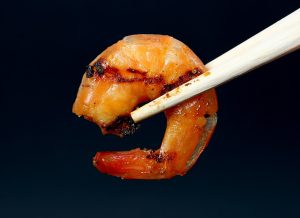
Shrimp are a delicious, healthy, and versatile seafood option that have been enjoyed by people for centuries. As a low-calorie and high-protein food, shrimp can provide a variety of health benefits when eaten as part of a well-balanced diet. Not only are shrimp a popular food choice, but they also offer a range of environmental benefits that make them an important part of our global food system.
Shrimp are a type of shellfish, most commonly identified by their long, slender bodies, fan-like tails, and grayish-white color. There are more than 2,000 species of shrimp worldwide, and they can be found in nearly every type of marine environment. Whether you’re looking for wild-caught or farmed shrimp, they are typically available in a variety of sizes and forms, including whole, peeled, de-veined, and cooked.
Nutritional Benefits of Shrimp
One of the key nutritional benefits of shrimp is its high protein content. Shrimp is a good source of lean protein, providing about 17g of protein per 3.5-ounce serving. Protein is essential for building muscle, repairing cells, and aiding in digestion. It also helps to keep us feeling full longer, which can help with weight loss and maintenance.
Shrimp is also a great source of omega-3 fatty acids, which can help reduce inflammation, improve brain health, and lower the risk of heart disease. It also contains a variety of vitamins and minerals, such as vitamin B12, selenium, zinc, and phosphorus. These vitamins and minerals help to support a healthy immune system, skin and hair, and overall health.
Shrimp is also low in calories, fat, and cholesterol, making it a great choice for those trying to lose weight or maintain a healthy weight. It’s also low in carbohydrates, which makes it a great option for those on a low-carb diet.
Shrimp can also be a great source of antioxidants. These antioxidants help to protect our cells from oxidative damage caused by free radicals, which can lead to diseases such as cancer and heart disease.
Shrimp can be a great source of iodine, a mineral that is essential for thyroid health. Without enough iodine, the thyroid can become overactive or underactive, leading to a number of symptoms such as fatigue, weight gain, and depression.
History of Shrimp
Shrimp have been an integral part of the human diet for thousands of years. According to research, shrimp were among the first seafoods to be fished and consumed by humans, with evidence of its consumption dating back to at least the ancient Greeks in 2,000 B.C. Although they were an important food source in ancient times, the history of shrimp is complex and often misunderstood.
Shrimp are a type of crustacean, which are marine animals with a hard outer shell and jointed legs. Most shrimp varieties are found in the warm waters of tropical and subtropical regions and can grow to a length of up to three inches. Shrimp are important members of the food chain, providing food for many other organisms, including fish and birds.
Shrimp have been a popular food source since antiquity. Evidence of early consumption of shrimp has been found in ancient Mediterranean cultures, and in 400 B.C. the Greeks were already harvesting the crustaceans from the Aegean Sea. In the Middle Ages, shrimp was a staple in the diets of many Europeans and is thought to have been a major part of the diets of many working classes.
The popularity of shrimp continued to grow, and in the 1800s, the cultivation of shrimp began in Europe and North America. In the United States, wild-caught shrimp were harvested from the Gulf of Mexico and the Atlantic coast. Shrimp fishing was a major industry in the South, with many farmers and fishermen relying on the crustaceans for their livelihood.
The market for shrimp increased exponentially in the 20th century. In the 1950s, the invention of refrigeration and freezing enabled the quick and easy transport of shrimp from one part of the world to another. This development helped to make shrimp an international commodity, with the majority of the world’s shrimp now being farmed and caught in countries such as Thailand, Indonesia, Vietnam, and India.
In recent years, the demand for shrimp has surged, with the United States being the world’s leading importer of shrimp. In 2018, Americans consumed over 1.3 billion pounds of shrimp. With this increase in popularity, comes the need to ensure that shrimp are harvested and farmed in an environmentally sustainable manner. To this end, the United States has implemented regulations and certifications that ensure that shrimp harvested and farmed domestically are done so in an ecologically responsible manner.
Cooking with Shrimp

Cooking with shrimp can be an incredibly rewarding experience. Not only is it one of the most versatile proteins out there, but it also cooks fairly quickly, making it a great choice for a variety of dishes. Shrimp also has a unique flavor that can add a delicious, umami-rich taste to a wide range of dishes. Whether you’re looking for a new way to enjoy this delicious seafood or just want to try something different, here are a few tips for cooking with shrimp.
1. Choose the right type of shrimp. Depending on what kind of dish you’re making, you’ll want to select the best type of shrimp for the job. Head-on shrimp are usually best for dishes that involve a longer cooking time, such as a stir-fry. On the other hand, peeled and deveined shrimp are usually best for dishes that require a shorter cooking time, like a shrimp scampi.
2. Start with fresh shrimp. When cooking with shrimp, always look for the freshest possible shrimp. Look for shrimp that are firm and smell like the ocean. Avoid any shrimp that have an ammonia smell or look slimy or mushy.
3. Avoid overcooking. One of the biggest mistakes people make when cooking with shrimp is overcooking them. Overcooked shrimp can become rubbery, tough, and dry. To avoid this, keep an eye on your shrimp while they’re cooking and remove them from the heat as soon as they’re done.
4. Marinate your shrimp. Marinating your shrimp before cooking will help to enhance their flavor and add a little extra moisture. You can use any marinade you like, but make sure to only marinate them for a short time (10-20 minutes) or else the acid in the marinade will start to break down the proteins in the shrimp and make them tough.
5. Get creative. Shrimp are incredibly versatile and can be enjoyed in a variety of dishes. Consider adding them to tacos, soups, pasta dishes, salads, and even pizza. You can also try different cooking methods such as grilling, baking, boiling, sautéing, and deep-frying shrimp.
6. Experiment with different flavors. Shrimp goes well with a variety of flavors, including garlic, lemon, herbs, and spices. Consider trying different combinations to see what you like best.
Cooking with shrimp can be a fun and rewarding experience. With a few simple tips and a bit of experimentation, you’ll be able to make delicious dishes that your family and friends will love. So why not give it a try?
Clinical Trials on Shrimp
Clinical trials are conducted to assess the safety and efficacy of a particular intervention or treatment. In the case of shrimp, clinical trials are being conducted to explore the potential health benefits of consuming shrimp. For example, a randomized controlled trial conducted by researchers from the University of South Florida evaluated the effects of shrimp consumption on blood pressure and cholesterol levels. This trial found that shrimp consumption reduced systolic blood pressure, improved total cholesterol levels, and reduced LDL (“bad”) cholesterol levels.
Other clinical trials are focusing on the potential effects of shrimp consumption on inflammation and heart health. For example, a study conducted by researchers from the University of Manchester found that omega-3 fatty acids extracted from shrimp could reduce inflammation and improve heart health. Similarly, a randomized controlled trial conducted by researchers from the University of Arizona found that shrimp consumption could reduce the risk of cardiovascular disease.
Challenges Facing Researchers
Despite the potential health benefits of consuming shrimp, there are still a number of challenges facing researchers. For example, most clinical trials are conducted on a small number of participants, which makes it difficult to draw definitive conclusions about the health effects of shrimp consumption. Furthermore, determining the long-term effects of shrimp consumption can be difficult, as most clinical trials are conducted over a short period of time. Another challenge is the lack of standardization in the way shrimp is consumed, as different types of shrimp may vary in their nutritional content.